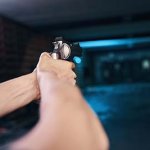
Unthinkable Tragedy Strikes at Siam Paragon: The 14-Year-Old Shooter
A 14-year-old boy walked into the bustling shopping center, Siam Paragon, in Bangkok, armed with a loaded Glock 19 and start killing people.
READ MORECALL US
+66 (0)2 114-3151
MAIL US
[email protected]

In the self-defense, martial arts, and tactical spaces, there is perhaps nothing more polarizing than knife attack defense. The industry loves cliches like:
“You will get cut.”
“Knives are meant to be felt, not seen.”
“Don’t bring a knife to a gunfight.”
“One person dies, one goes to the hospital.”
“Never…”
“Always…”
...and on and on. Like most cliches, they contain elements of truth but are generally oversimplified, misunderstood, misapplied, or sometimes, just utter BS.
Anyone should know that when it comes to interpersonal violence, knife attacks and threats the most frightening to deal with, and I you should always try to avoid them. But if avoidance is not an option, there are a few things everyone should know — about the weapon, the user, and the defensive response.
Edged weapons rarely fail. Unlike firearms, they have very few, if any, mechanical components. Blades do not run out of ammunition. Blades do not have a “line of fire,” as most of what is exposed is dangerous, and once presented, blades are always live. Unlike firearms, edged weapons are often weapons of convenience, gleaned from the environment during a violent encounter, and are therefore more prevalent: knife, screwdriver, scissors, pen, machete, and more. Furthermore, edged weapons are quite common in crimes of passion/emotion, and we generally see numerous stabs and slashes in an attack.
Here’s the dirty little secret that martial artists and knife nerds don’t want you to know: You do not need to be skilled with a knife to do massive damage. What you need is intent. Everyone with a knife has the potential to be deadly. The mentality of someone willing to use a knife as opposed to a gun, for example, is pretty stark. A firearm is (primarily) designed and intended as a distance weapon. The user is not required to touch the victim/target.
With a knife, the user must be willing to run a piece of steel through skin and muscle and bone and tendon and whatever else might be in the way. This is someone comfortable with (at least with the idea of) getting bloody, and feeling the life leave another human. This is not “required” with really any other weapon. This is an incredibly important thing to remember when dealing with a knife attack or threat.
The defender must be willing to meet such an attacker with comparable or superior aggression and intent. It also turns out that most people have handled edged weapons, in one form or another, the majority of their lives, so it is something very familiar to them.

If at all possible, avoid bad places and situations, and do not engage someone with a knife unless you have no other viable options. But since this is not always possible, keep in mind that the variable you ultimately control is you. The time and energy you put into learning to deal with such encounters are your responsibility, and might be the only things that keep you alive should things get bad. (Good) training matters. Prepare to protect what matters most.

A 14-year-old boy walked into the bustling shopping center, Siam Paragon, in Bangkok, armed with a loaded Glock 19 and start killing people.
READ MORE
A 14-year-old boy walked into the bustling shopping center, Siam Paragon, in Bangkok, armed with a loaded Glock 19 and start killing people.
READ MORE
There are several ways by which hiring a private investigator can make your life easier. They will help you with the Investigation and they care about your Secret. Privacy and Safety, plus they provide a good service and save your time.
READ MORE
Nobody can hold a gun perfectly still, especially when under attack, so shoot as quickly as you can while maintaining your hits.
READ MORE